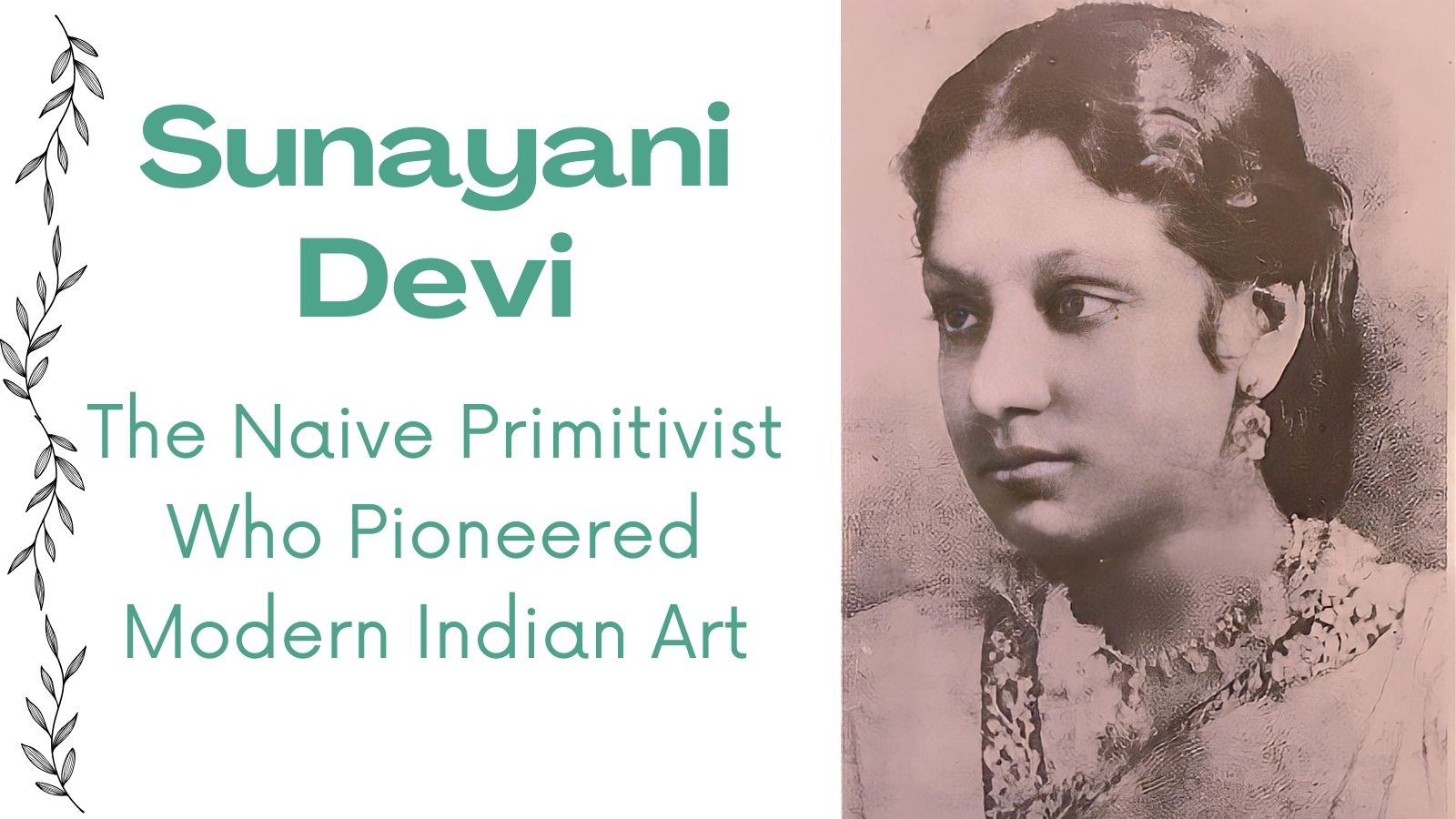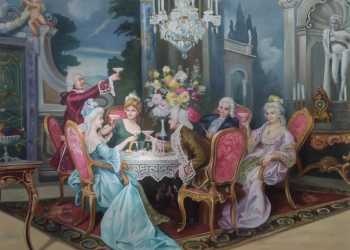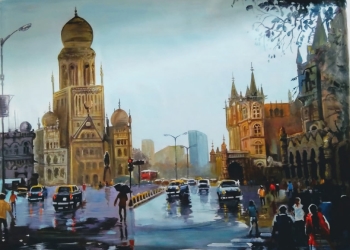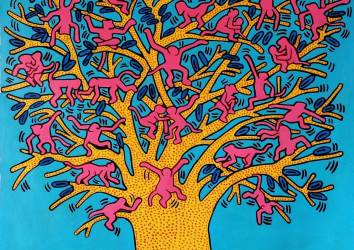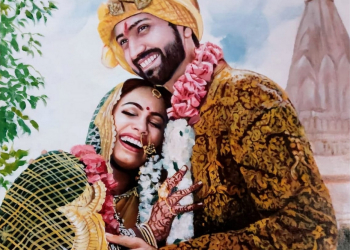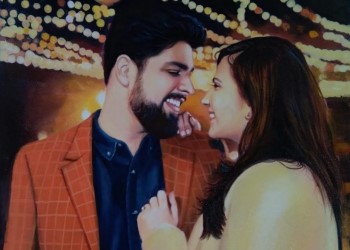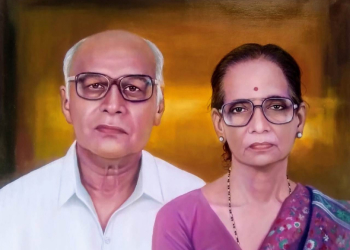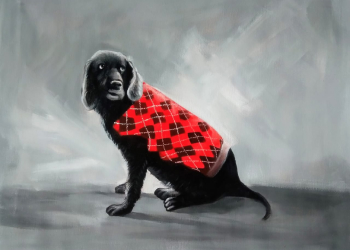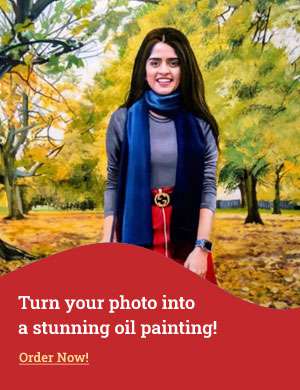Sunayani Devi: The Naive Primitivist Who Pioneered Modern Indian Art
Sunayani Devi is widely acknowledged as one of the first woman artists in India known for her delicate and eloquent watercolors. A pioneer of primitivism and modern art in India. In this post we learn more about her life and work
Sunayani Devi pioneering modern Indian Woman artist
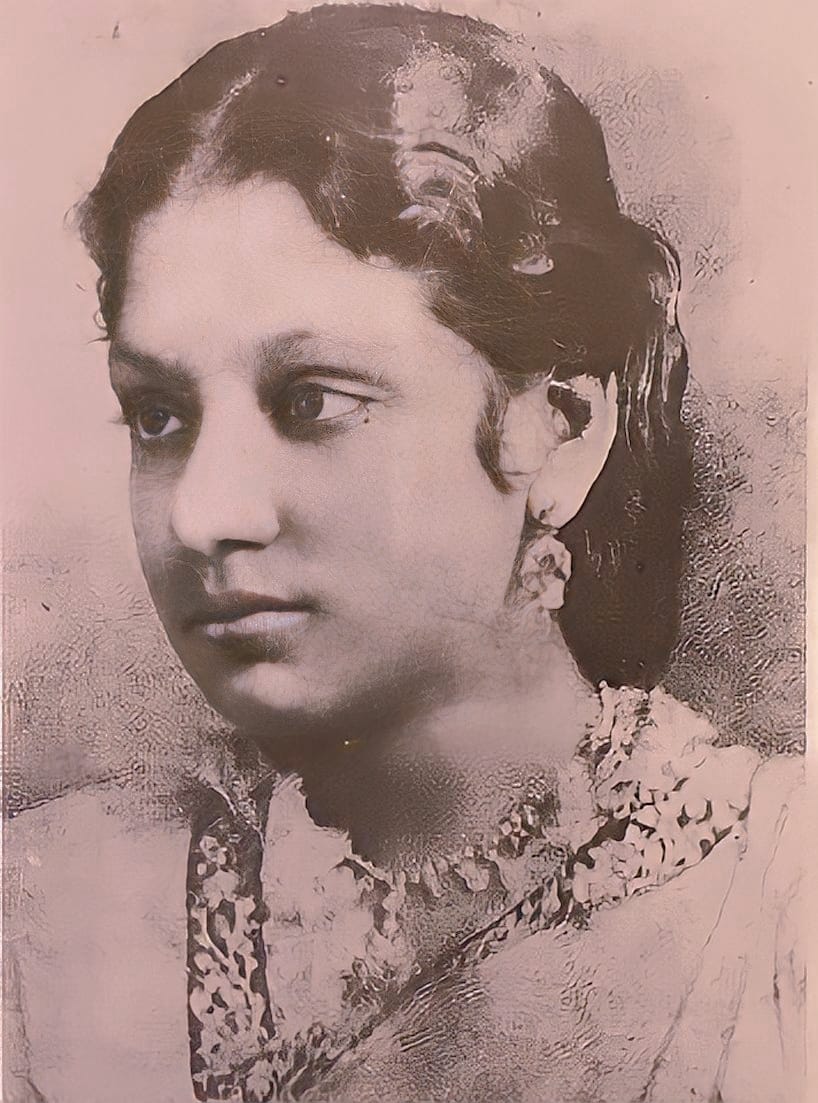 Sunayani Devi (1875 – 1962)
Sunayani Devi (1875 – 1962)
Sunayani Devi (1875 – 1962) was a pioneering modern Indian artist who made a remarkable contribution to modern Indian art in the early 20th century. Sunayani Devi's bold and original paintings were appreciated by critics for their fresh primitivist aesthetic when academic naturalism dominated the art scene. Though initially just a keen amateur, her creative talents blossomed due to the encouragement of her eminent family - especially her uncle Rabindranath Tagore and brothers Abanindranath, Gaganendranath and her husband Rajanimohan Chattopadhyaya, grandson of Raja Ram Mohan Roy. Her unique style of painting inspired by Indian folk and tribal art was promoted by the Austrian art historian Stella Kramrisch as a modern embodiment of ancient Indian mural painting traditions. Though she lacked formal training and painted for only 15 years, Sunayani Devi's naive, childlike works influenced the trajectory of avant-garde art in colonial India.
Sunayani Devi Her Birth and Background
Sunayani Devi was born in 1875 in Calcutta, into the illustrious Tagore family that played a leading role in the Bengal Renaissance. Her parents were Gunendranath Thakur and Soudamini Devi. In 1887, at the young age of 12, she was married to Rajanimohan Chattopadhyaya. Sunayani grew up in a household buzzing with cultural and artistic activity due to her eminent relatives, but gender norms restricted her access to formal education or art training. Her uncle, the Nobel laureate poet Rabindranath Tagore, mentions in his memoirs that in the Tagore family, the men lived in the outer quarters while women inhabited the inner sections.
Sunayani's brothers Abanindranath Tagore and Gaganendranath Tagore were both pioneering modern artists associated with the Bengal School of Art. But like most aristocratic women of her background, Sunayani’s education was limited to learning feminine accomplishments like music and the vernacular language at home. Sculptor Amina Kar noted, “It was unknown and unheard of for women to do anything, even “Art”, on a professional basis,” in art Historian Partha Mitter's book, The Triumph of Modernism India’s Artists and the Avant-garde. Her male relatives embodied the colonial elite’s dual consciousness, using English for public purposes and Bengali at home. Women like Sunayani Devi were confined to domesticity and expected to uphold tradition.
Development of Sunayani Devi’s Primitivist Style as an Artist
Sunayani Devi was drawn to painting from childhood, fascinated by the devotional Raja Ravi Varma paintings and lithograph prints of his artworks she saw around her. But she began painting only around 1908, in her thirties, encouraged and supported by her husband. Inspired by her brothers’ modern style, she started exhibiting her works in 1915 at the Indian Society of Oriental Art founded by the Tagores. Her early oil paintings were portraits and scenes from religious Hindu mythology, Gods and epics.
Sunayani Devi developed a unique primitive, childlike style inspired by Bengal folk art forms like Kalighat Pat painting and indigenous dolls. Her figures had curving, rounded outlines and minimal modeling. She employed the wash technique perfected by Abanindranath using soft pastel blues, yellows, greens, and browns. Critics noted her novel approach that discarded realism and Western academic techniques in favor of a linear rhythm and flat colors. In 1925 the Calcutta newspaper The Statesman wrote glowingly that even though she was a woman, her works showed “vigor and originality”.
Handmade Art Reproductions & Landscape Paintings
Sunayani Devi's Discovery by Stella Kramrisch
Sunayani Devi's talent was discovered and promoted by the eminent Austrian art historian Stella Kramrisch in the West. In 1922 essays in influential German journals, Kramrisch acclaimed the "simplicity and spontaneity" of Sunayani Devi's untutored talent. She noted that Sunayani Devi's paintings lacked preliminary sketches and seemed to organically evolve on the canvas through washes of color. Kramrisch wrote of her confident flowing lines that expressed both tranquility and energetic spirit.
Kramrisch placed Sunayani Devi's art in the universal tradition of modernist primitivism, comparing it to medieval Sienese painters. But she also emphasized its Indianness, interpreting it as a modern extension of ancient mural painting and contemporary folk art. Kramrisch claimed that like the heritage of Ajanta frescoes flowed into her art. She highlighted how Sunayani Devi's style and themes were inspired by doll art, village women's paintings, and Kalighat Pats.
Art Historian Partha Mitter notes that Kramrisch is conspicuously silent on the influences of Raja Ravi Varma and her brother and founder of Bengal School of Art Abanindranath Tagore on her work. Partha Mitter speculates, “Her naïve work was singled out as a continuation of the ‘simple’ art of the Indian village, a contemporary expression of authentic India.”
Partha Mitter further notes that Kramrisch’s portrayal of Sunayani Devi as a naïve folk artist overlooked her privileged urban upbringing. While emphasizing the authenticity of her untutored talent, Kramrisch interpreted it as a direct expression of the Indian nation's living ancient traditions, unlike Bengal School Artists whom she felt were unable to recapture in their modern revivalism.
Appreciation of Sunayani Devi works by Western Artists
In the 1920s, Sunayani Devi's paintings were acclaimed by European modernists who appreciated her unique style and technique. The Austrian painter Nora Wuthenbrach contributed an effusive essay about Sunayani Devi for her show at London’s Women’s International Art Club in 1927. She was charmed by the expressive, lotus-eyed women and enchanting colors of Devi's paintings. Wuthenbrach also noted their monumental figures and flat application of colors reminiscent of frescoes. She wrote eloquently "A breath of life from a distant past seemed to pervade them.”
Sunayani Devi’s paintings were also exhibited internationally alongside the avant-garde works of the Bauhaus group. Progressive European artists like Wassily Kandinsky were impressed by her use of brilliant colors, in the manner of European Expressionists. They admired her application of flat, unmodeled colors and monumental figures floating in dreamlike space. While they appreciated the modernist elements, the key attraction for Western artists was the exotic, primitive charm of Sunayani Devi's style which seemed redolent of ancient Eastern spirituality.
Sunayani Devi - Her Exhibitions
Sunayani Devi participated extensively in exhibitions from 1908 to 1927 in India and major Western art capitals. This provided invaluable exposure for a woman artist at a time when even male artists found it difficult to access the international modernist circles. Her paintings were shown at important Indian venues like the exhibitions organized by the Indian Society of Oriental Art, co-founded by her family.
In 1911, she was one of the very few Indian artists invited to exhibit at the prestigious Festival of Empire show in London held to commemorate the coronation of King George V. This helped showcase her talent to an international audience. Throughout the 1920s, her work was also displayed in major shows in the U.S., Germany, and the UK alongside stalwarts like the Bauhaus group. A retrospective exhibition of her work held at her Calcutta home in 1935 finally cemented her reputation as a significant pioneer of modernist primitivism in Indian art.
Museums and Collections
Though she painted for barely 15 years, Sunayani Devi's pioneering modernist works were collected by leading institutions, helping preserve her legacy. Today her artworks can be seen at national institutions like the National Gallery of Modern Art (NGMA) Delhi/Bengaluru, National Art Gallery Chennai, Calcutta Museum (now Kolkata), and Sri Chitra Art Gallery Thiruvananthapuram.
Prestigious collections like the Jaganmohan Palace Mysore also house significant works by Sunayani Devi. Her art is part of the permanent displays of the Rabindra Bharati University Museum in Kolkata, which specializes in the Tagores' legacies.
What are the famous paintings of Sunayani Devi? The Best Paintings of Sunayani Devi
Some of Sunayani Devi's most acclaimed and seminal paintings are:
Ardhanarisvar (1920s): A striking rendition of the androgynous half-male, half-female form of Lord Shiva and Parvati. The flat colors and childlike simplicity added originality.
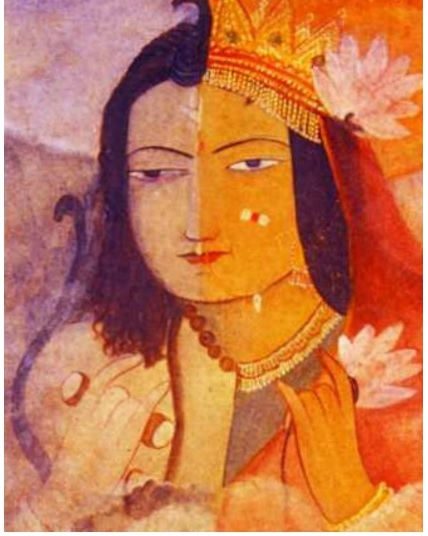 Ardhanarishwar by Sunayani Devi (Image Credits: The Triumph of Modernism India’s Artists and the Avant-garde)
Ardhanarishwar by Sunayani Devi (Image Credits: The Triumph of Modernism India’s Artists and the Avant-garde)
Title: Ardhanarisvar
Creator: Sunayani Devi
Date Created: 1920
Medium: Watercolor on paper
Milk Maids (1925): Lyrical work showing two village milkmaids in fluid pink and blue carrying brass matkas (pots). Evokes nostalgia for pastoral life.
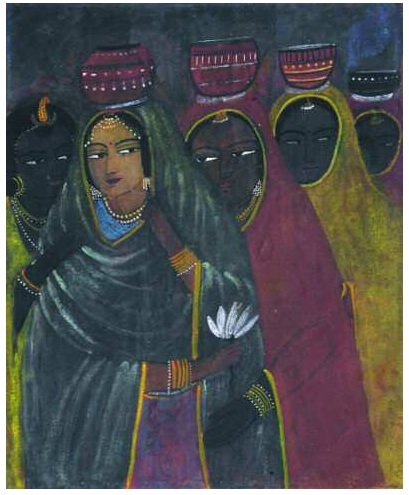 Milkmaid painting by Sunayani Devi (Image Credits: The Triumph of Modernism India’s Artists and the Avant-garde)
Milkmaid painting by Sunayani Devi (Image Credits: The Triumph of Modernism India’s Artists and the Avant-garde)
Title: Milk Maids
Creator: Sunayani Devi
Date Created: 1925
Physical Dimensions: 13.46 inches × 13.19 inches (34.2 cm × 33.5 cm)
Medium: Watercolor on paper
Location: National Gallery of Modern Art, Bengaluru, India
Lakshmi: A dreamy poetic composition of the Hindu Goddess of Wealth Lakshmi. With a golden tiara on her head holding a golden pot in her hand and a lotus flower.
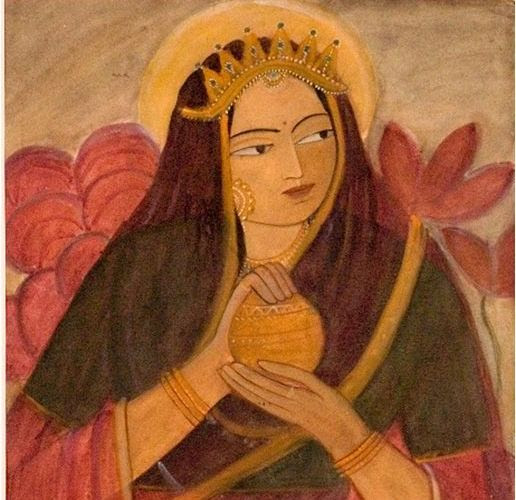 Lakshmi painting by Sunayani Devi (Image Credits: IndianCulture.Gov.in - Ministry of Culture)
Lakshmi painting by Sunayani Devi (Image Credits: IndianCulture.Gov.in - Ministry of Culture)
Title: Lakshmi
Creator: Sunayani Devi
Date Created: 20th Century
Physical Dimensions: 13.46 inches × 13.78 inches (34.2 cm × 35 cm)
Medium: Wash, Tempera, Paper
Location: National Gallery of Modern Art, New Delhi, India
Viraha: Viraha is a state of mind when longing for one's lover. The dreamy composition depicts a woman in a blue saree looking at the setting sun, lost in thoughts of her lover.
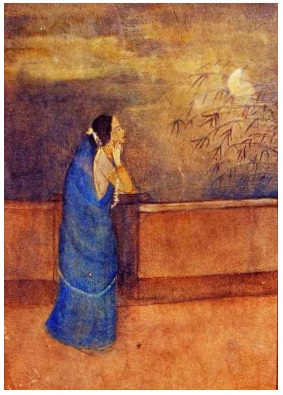 Viraha painting by Sunayani Devi (Image Credits: The Triumph of Modernism India’s Artists and the Avant-garde)
Viraha painting by Sunayani Devi (Image Credits: The Triumph of Modernism India’s Artists and the Avant-garde)
Order Your Portrait Painting from Photo today
Radha Krishna: The painting Radha Krishna depicts Krishna playing the flute for Radha as she rests her head on Krishna’s shoulders. The traditional pose of Radha Krishna painting is imbued with soft lyrical dreaminess, which became the hallmark of Sunanyani Devi’s paintings
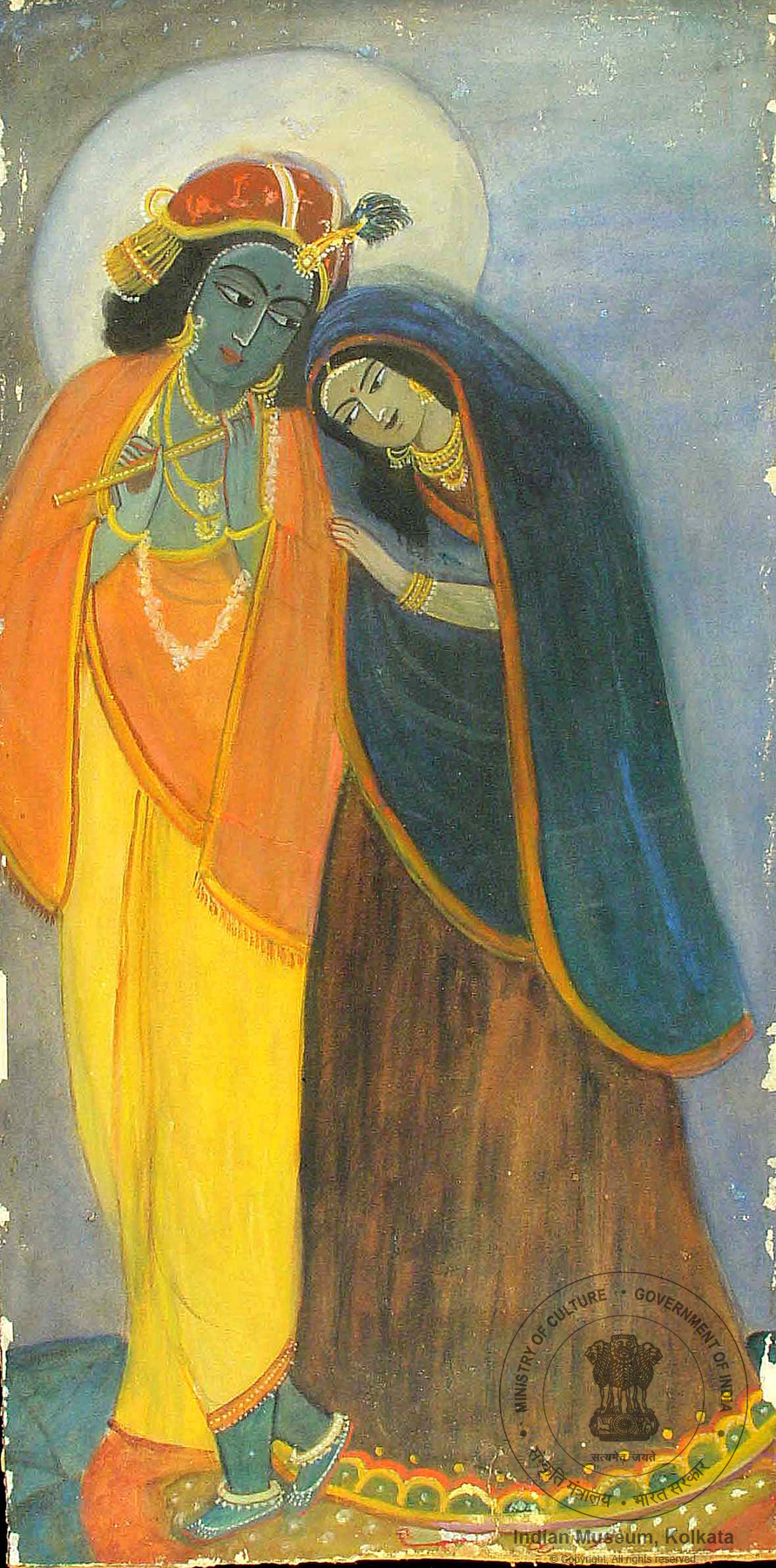 Radha Krishna painting by Sunayani Devi (Image Credits: Indian Museum, Kolkata)
Radha Krishna painting by Sunayani Devi (Image Credits: Indian Museum, Kolkata)
Title: Radha Krishna
Creator: Sunayani Devi
Date Created: 20th Century
Physical Dimensions: 19.38 inches × 16.87 inches (49.2 cm × 42.8 cm)
Medium: Watercolor on paper
Location: Indian Museum, Kolkata, India
Yashoda and Krishna: A charming scene of mother Yashoda playfully feeding the infant Krishna with other children surrounding them. Noted for its expressive, innocent mood.
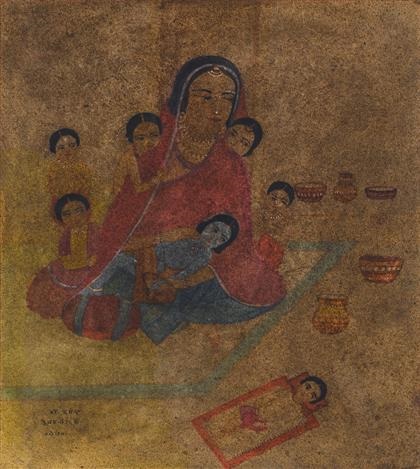 Yashoda and Krishna wash painting by Sunayani Devi (Image Credits: Artnet)
Yashoda and Krishna wash painting by Sunayani Devi (Image Credits: Artnet)
Title: Yashoda and Krishna
Creator: Sunayani Devi
Date Created: 1938
Physical Dimensions: 19.38 inches × 16.87 inches (49.2 cm × 42.8 cm)
Medium: Watercolor on paper
Location: Private Collection
What did Sunayani Devi contribute to the visual arts?
Sunayani Devi made an important contribution to modern Indian art in several ways:
-
She pioneered a primitivist pictorial style inspired by indigenous folk and tribal arts like Kalighat pat painting. This provided an alternative to the academic realism promoted by British and European colonial art schools.
-
Her lyrical, childlike paintings evoking nostalgia and innocence introduced a new modernist vocabulary of expressionistic colors, rhythmic lines, and flat space.
-
She inspired modernists to turn to Indian traditional arts and crafts like Madhubani, Kalamkari etc as sources for developing an indigenous aesthetic.
-
Her success as an untrained amateur artist challenged prevailing notions that academic training was necessary for modern art, paving the way for other pioneering autodidacts.
-
She was among the earliest Indian artists to gain international recognition and appreciation for her modernist primitivist works.
-
Along with Amrita Sher-Gil, she paved the way for future generations of modern Indian women artists to pursue art professionally.
-
Her art exemplified the Bengal School's Swadeshi nationalism by projecting a strong cultural nativist identity rejecting Western realism.
-
She helped shape the trajectory of Indian modernism by demonstrating that abstract indigenous idioms could powerfully express the spirit of modernity.
Sunayani Devi opened a new creative path for modern Indian artists turning to their cultural roots and imagination rather than Western realism.
Conclusion
Sunayani Devi made an invaluable contribution to the development of modern Indian art in the early 20th century. Though an untrained amateur artist bound by domesticity, she produced pioneering works that spearheaded an influential primitivist movement. By indigenizing modernism, she enabled Indian art to find its authentic nativist voice in response to European academic realism. Sunayani Devi's brief but seminal career opened new creative directions for modern artists grounded in their cultural roots. Her sensitive, lyrical paintings stand as an outstanding embodiment of the inventive spirit of early modernist experimentation in Indian art.
Order Your Custom Handmade Oil Portrait Painting from Photo today
About Us:
Paintphotographs.com is India's leading custom art platform. We turn your favorite photos, pics, and images into luxurious handmade portrait paintings. Our work includes handmade portraits, custom oil reproductions, charcoal drawings, and sketches. As a team of accomplished artists, we use museum-quality canvas, the best international brands of colors such as Winsor & Newton and Daler Rawney. We work with various mediums, including oil, acrylic, mixed media, graphite, and charcoal.
To order a custom handmade oil portrait painting you can visit our order now page. You can order custom Wedding Paintings, Couple Paintings, Memorial Paintings, Family Paintings, Baby portraits and Children Paintings, Photo to paintings, and Pet Portrait Paintings from Photo.
You can visit our pricing page to know the prices of our portrait paintings. To connect with us ping us on our chat messenger on the website, ping us on WhatsApp, call us at 918291070650, or drop us an email at support@paintphotographs.com
You can visit our gallery pages to see our work. We make photo to paintings, couple paintings, memorial paintings, Kids and Baby Portrait paintings, God & Religious Paintings, Old Photo to Paintings, Wedding couple Paintings & Marriage Portraits, Family Paintings, Pet Portrait Paintings, Radha Krishna Paintings, Oil Portraits of Gurus, Saints & Holy Men, Charcoal and Pencil Sketches, Custom Landscape & Cityscape paintings, Contemporary Art Reproduction & Replica Paintings, Old Master Reproduction & Replica Art, Monochrome and Black & White portrait paintings, Historical Portraits and Shivaji Maharaj Paintings, Celebrity & Political Leaders Portraits. We can also merge separate photos to create a single seamless painting called Composite portraits to add deceased loved ones to make a family oil portrait as though they were present.
Our custom handmade portraits make beautiful Anniversary Gifts, Engagement Gifts, Birthday Gifts, Retirement Gifts, Housewarming Gifts, Mother's Day gifts, and luxurious gifts for many important occasions.
Paintphotographs.com provides bespoke services for art patrons, interior designers, and architects. It helps you create the perfect pieces for residential and commercial projects and serves as a platform for artists to showcase their work.
If you are an art aficionado interested in writing a guest post on art, connect with us.
Want to read more? Check our reading recommendations below! Please refer to the Notes and Reference section for sources referenced in the article.
Like this story? Then you will love our podcasts on Spotify. Listen to our deep dives and fascinating stories from the art world. Join our nearly 20,000-strong community on Facebook, WhatsApp, and X.
Want to see our art? Join our community of 500,000+ subscribers on the Paintphotographs YouTube channel, Instagram, and Pinterest for some amazing art pics & art videos!
Recommended Pieces
How to Convert Your Photo into a Canvas Portrait Painting Online - Handmade
A Closer Look at the Stunning Paintings in Coca-Cola's Latest Ad “Masterpiece” | Paintphotographs
The paintings in John Wick Chapter 4 | Paintphotographs
The life and paintings of artist and painter KCS Paniker | Paintphotographs
Why is Monalisa so famous? Monalisa's portrait painting history | Paintphotographs
Memorial Paintings - The Ultimate Guide to Commissioning one | Paintphotographs
India's Greatest Portrait Painters: Lives of 13 Oil Portrait Painting Masters | Paintphotographs
Ultimate 20 Best Oil Portrait Paintings of John Singer Sargent (Ranked) | Paintphotographs
10 Famous Romantic Raja Ravi Varma Paintings | Paintphotographs
The Artistic Genius of Abanindranath Tagore: Rediscovering His Early Works | Paintphotographs
Notes and reference section
https://www.google.co.in/books/edition/The_Triumph_of_Modernism/krdWkzVLSbkC?hl=en
Yashoda and Krishna by Sunayani Devi on artnet
https://www.museumsofindia.gov.in/repository/record/ngma_del-ngma-00354-4130
https://www.museumsofindia.gov.in/repository/record/im_kol-AT-90-1367-6519

